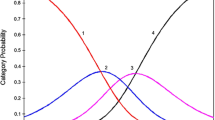Abstract
The objective of this paper is to review the psychometric properties of the new DSM-III-R criteria for autism. Five data sets were evaluated according to a set of methodological criteria. The results indicate that the DSM-III-R criteria for autistic disorder have, on average, very good sensitivity, but much lower specificity. The implications of this are (a) greater numbers of children diagnosed as autistic; (b) greater numbers of children misdiagnosed as autistic; and (c) greater heterogeneity among samples of autistic children. In essence, the DSM-III-R criteria act more like screening tests than diagnostic criteria. Conceptual and methodologic issues in the evaluation of diagnostic criteria are discussed.
Similar content being viewed by others
References
American Psychiatric Association. (1980).Diagnostic and statistical manual of mental disorders (3rd. ed.). Washington, DC: Author.
American Psychiatric Association. (1987).Diagnostic and statistical manual of mental disorders (3rd. ed., Rev.). Washington, DC: Author.
Bender, L. (1947). Childhood schizophrenia: Clinical study of one hundred schizophrenic children.American Journal of Orthopsychiatry, 17, 40–56.
Boyle, M. H., Offord, D. R., Racine, Y., Fleming, J. E., Szatmari, P., & Sanford, M. (1992). Evaluation of the revised Ontario Child Health Study Scales.Journal of Child Psychology and Psychiatry (In press).
Brunshaw, J. M., & Szatmari, P. (1988). The agreement between behavior checklists and structured psychiatric interviews for children.Canadian Journal of Psychiatry, 33, 474–481.
Cicchetti, D. V., & Sparrow, S. S. (1981). Developing criteria for establishing interrater reliability of specific items. Application to assessment of adaptive behavior.American Journal of Mental Deficiency Research, 8, 127–137.
Creak, M. (1961). Schizophrenia syndrome in children: Progress report of a working party.Cerebral Palsy Bulletin, 3, 501–504.
Denckla, M. B. (1986). New diagnostic criteria for autism and behavioral disorders: Guidelines for research protocols.Journal of the American Academy of Child and Adolescent Psychiatry, 25, 221–224.
Factor, D. C., Freeman, N. L., & Kardash, A. (1989). Brief report: A comparison of DSM-III and DSM-III-R criteria for autism.Journal of Autism and Developmental Disorders, 19, 637–640.
Feinstein, A. R. (1977). A critical overview of diagnosis in psychiatry. In V. Rakoff, H. C. Stancer, & H. B. Kedrand (Eds.),Psychiatric Diagnosis. New York; Brunner-Mazel.
Galen, R. S., & Gambino, S. R. (1975).Beyond normality: The predictive value and efficiency of medical diagnoses. New York; Wiley.
Hertzig, M., Snow, M. E., New, E., & Shapiro, T. (1989). DSM-III and DSM-III-R: Diagnosis of autism and PDD in nursery school children.Journal of the American Academy of Child and Adolescent Psychiatry, 29, 123–136.
Kanner, L. (1943). Autistic disturbances of affective contact.Nervous Child, 2, 217–250.
Ritvo, E. R., & Freeman, B. J. (1977). National Autistic Society definition of the syndrome of autism.Journal of Pediatric Psychology, 2, 146–148.
Robins, L. H. (1985). Epidemiology: Reflections on testing the validity of psychiatric interviews.Archives of General Psychiatry, 42, 918–929.
Rutter, M. (1978). Diagnosis and definition. In M. Rutter & E. Schopler (Eds.),Autism: A reappraisal of concepts and treatment. New York: Plenum Press.
Sackett, D. L., Haynes, R. B., & Tugwell, P. (1985). The interpretation of diagnostic data. InClinical epidemiology: A basic science for medicine. Toronto: Little, Brown.
Shrout, P. E., & Fleiss, J. L. (1981). Reliability and case detection. In J. K. Wing, P. Bebbington, & L. N. Robins (Eds.),What is a case? London: Grant McIntyre.
Siegel, B., Vukicevic, J., Elliott, G. R., & Kraemer, H. C. (1989). The use of signal detection theory to assess DSM-III-R criteria for autistic disorder.Journal of the American Academy of Child and Adolescent Psychiatry, 28, 542–548.
Spitzer, R. L., & Siegel, B. (1990). The DSM-III-R field trial of pervasive developmental disorders.Journal of the American Academy of Child and Adolescent Psychiatry, 29, 855–862.
Spitznagel, E. L., & Helzer, J. E. (1985). A proposed solution to the base rate problem in the kappa statistic.Archives of General Psychiatry, 42, 725–728.
Szatmari, P. (1989, October).Differential diagnosis of Asperger syndrome and autistic disorder using DSM-III-R. Paper presented at the meeting of the American Academy of Child and Adolescent Psychiatry, New York.
Szatmari, P. (1992). The validity of autistic spectrum disorders: A literature review.Journal of Autism and Developmental Disorders, 22, 583–600.
Volkmar, F., Cohen, D. J., & Paul, R. (1986). An evaluation of DSM-III criteria for infantile autism.Journal of the American Academy of Child Psychiatry, 25, 190–197.
Volkmar, F. R., Bregman, J., Cohen, D. J., & Cicchetti, D. V. (1988). DSM-III and DSM-III-R diagnoses of autism.American Journal of Psychiatry, 145, 1404–1408.
Walter, S. D., & Irwig, L. M. (1988). Estimation of test error rates, disease prevalence and relative risk from misclassified data: A review.Journal of Clinical Epidemiology, 41, 923–937.
Waterhouse, L., Wing, L., Spitzer, R., & Siegel, B. (1992). Pervasive developmental disorders. From DSM-III to DSM-III-R. Journal of Autism and Developmental Disorders, 22, 525–549.
World Health Organization. (1978). InMental disorders: Glossary and guide to their classification in accordance with the ninth revision of the international classification of diseases. Geneva: Author.
Author information
Authors and Affiliations
Additional information
This paper was prepared for the DSM-IV Advisory Committee on Pervasive Developmental Disorders, although the opinions expressed are solely those of the author and do not necessarily reflect those of the Committee or the American Psychiatric Association. The author thanks the members of the Committee, and Drs. Tom Widiger, Bryna Siegel, Fred Volkmar, and Mike Boyle for their very helpful comments. The author was supported in the preparation of this paper by grants from Health and Welfare, Canada, and The Ontario Mental Health Foundation.
Rights and permissions
About this article
Cite this article
Szatmari, P. A review of the DSM-III-R criteria for autistic disorder. J Autism Dev Disord 22, 507–523 (1992). https://doi.org/10.1007/BF01046325
Issue Date:
DOI: https://doi.org/10.1007/BF01046325




